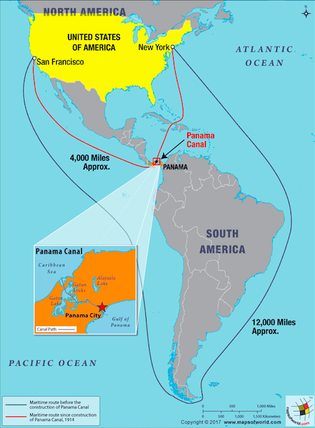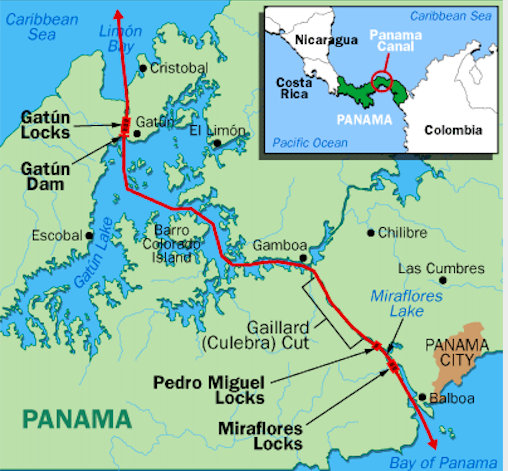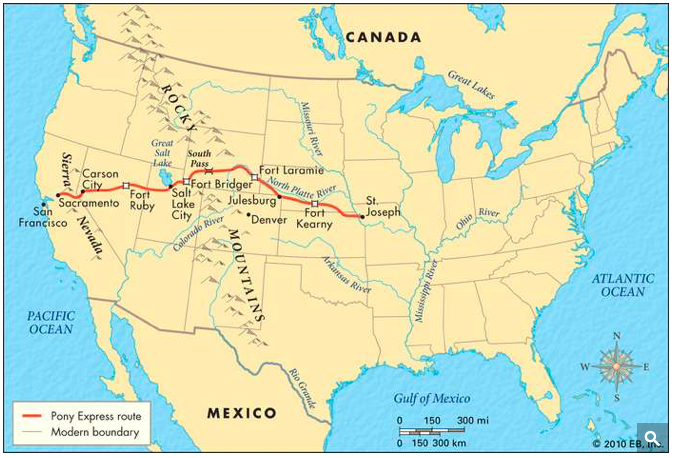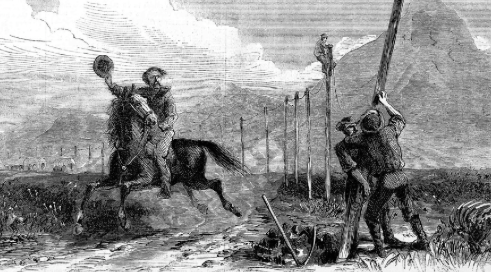 The passage across Panama was only one-third the distance around South America.
The passage across Panama was only one-third the distance around South America. Roger McCoy
In 1502 Columbus made one last effort to find a passage through that annoying land obstruction that kept him from the real Indies. He reached Central America and sailed down the coast from Honduras to Panama but found no water passage westward.
If Columbus had not needed to reach safety quickly due to his rotting ships, he might have tried to talk with the local natives in Panama and discovered how close he was to the Pacific Ocean. Eleven years later Balboa did talk with the natives.
Vasco Núñez de Balboa came to the Panama coast in 1513 (see Explorer’s Tales 5/20/2014). He made a forty-five mile crossing by hacking his way through dense forests, swamps, across lakes, and over mountains with native guides. This gave him the distinction of being the first European to cross the Isthmus and see the eastern shores of the Pacific Ocean. He then bestowed the name Pacific to this vast sea and claimed all lands and islands touching it for Spain. Of course he had no idea that all of east Asia bordered the same ocean. Needless to say, other world powers over the the next centuries payed no attention to his claim. In the mid-eighteenth century Captain James Cook actually sailed the Pacific Ocean several times and claimed for England almost everything he saw.
The Spanish made soon made good use of Balboa’s discovery of a short land route between the two big oceans. When Pizarro found treasures of gold in Peru, the Spanish took their loot by sea to Panama, trekked on foot across the Isthmus and reloaded it onto ships bound for Spain
Balboa’s trip across the wilds of Panama served a purpose much greater than claiming the entire Pacific Ocean and all the lands that border it. He also showed the world that the two continents blocking the path to the Orient had a narrow place only about forty-five miles wide. Many years later when the west coast of North America became populated and California became a magnet during the gold rush, ships still had to make the long and difficult voyage around South America’s Cape Horn. It was easy to see that a ship traveling from New York to San Francisco could save almost 8,000 miles and five months of travel if they could cross the Isthmus of Panama.
When the California gold rush began, fortune seekers tried all routes and means of transport possible to get to the gold fields. Many arrived at the Caribbean Sea coast of Panama hoping to cross somehow and board another ship to California. At first there were no trails and no transportation infrastructure across the Isthmus. The old Spanish trail had been abandoned and reclaimed by the jungle and only dugout canoes existed for local trade on the Chagres River. People tried desperately to find a way through the tropical jungle just as the first Spanish explorers did 350 years earlier. Those who could afford it resorted to an expensive trip in a dugout canoe. Although portage was needed in some places, they eventually arrived at Las Cruces on the Pacific coast and then crowded aboard a steamer bound for San Francisco. Crossing the Isthmus at that time for ordinary travelers was possible only on foot or by mule.
One of the venturesome wealthy travelers who crossed Panama in that era was Jessie Benton Frémont, wife of John C. Frémont and the daughter of a well-known Senator from Missouri, Thomas Hart Benton. She was a socially prominent woman who chose to shorten her trip from New York to San Francisco by crossing the Isthmus in 1849, six years before the railroad was built. She noted that U.S. Army surveyors were beginning to map the route for a railroad.
Jessie Fremont kept a diary of her entire trip and later wrote a book, “A Year of American Travel,” in which she related her experience crossing the Isthmus. She described changing from large ship to small river boat, of which she wrote, “The little tender on which we were loaded was like stepping down into a toy.”
After eight miles the river became smaller and passengers were transferred to dugout canoes and continued up the river. Mrs. Frémont, however, managed avoid the canoe ride and wrangled a ride in a somewhat bigger boat with a responsible crew. She wrote, “It took a long time… we made only a few miles each day.” She indicated that each day was full of “novelty and interest.” But when night came in the tropical forest there rose “a hideous, confusing rush of sound.”
When they could go no farther by boats they loaded their trunks on mules. At each stage of the journey Jessie became more aware of the strangeness of the place but also its breathtaking beauty.
The whole thing was like a nightmare… The nights were odious with their dank mists and noises; but there was compensation in the sunrise when you looked down from a mountain into an undulating sea of magnificent blooms sending up clouds of perfume into the freshness of the morning. … And from the last of the peaks we saw, as Balboa had seen before us, the Pacific at our feet.
Jessie Frémont made this difficult trip despite an illness from lung congestion which began during her voyage from New York to Panama. She described the illness as a danger to her life and worried that no leeches or croton oil (a purgative) were available.
Among many others who made the Panama crossing were the famous Siamese twins Chang and Eng. They departed New York City on November 12th, 1860 by steamship, crossed Panama by train, and arrived in San Francisco twenty-four days later on December 6th.
Despite the hardships, the journey across the Isthmus of Panama was faster than the overland trek across western North America or the voyage around the Horn. It took about two months to get to San Francisco by crossing the Isthmus compared to six months from the east coast across North America overland with oxen or sailing around Cape Horn. The great demand for travel across the Isthmus became an opportunity for the railroad builders to step in and provide transport across Panama.
American businessmen financed construction of a railroad beginning in 1850 on the Caribbean side near the present site of Colón. Because the first six miles of the route were swampland, progress was very slow and expensive. Much of the construction had to be supported by pilings with rock backfill. A greater problem was illness among the workers. An estimated 5,000 to 10,000 deaths from tropical diseases occurred during the railroad construction, particularly malaria, yellow fever, cholera, and dengue fever. Mosquitos were the carrier of the malaria, yellow fever, and dengue viruses, and water contamination was the source of the cholera bacteria. Unfortunately little was known about these tropical diseases or their means of transmission so treatment was ineffective.
In late 1851, after more than a year, railroad construction reached the the city of Gatún, a distance of only ten miles from the Atlantic coast. The construction company’s initial funds of one million U.S. dollars were expended, but they created a cash flow by offering rail passenger service between Colón and Gatún.
The Panama Railroad Company finally finished the route in 1855, at a point a few miles from Panama City on the Pacific side and the completed line immediately attracted passengers. This forty-seven mile railroad gave a tremendous incentive to travelers to take the Panama route and it was an immediate success. One traveler reporting on his trip wrote of a “groggery” at the terminus where passengers could buy bad brandy before finishing the last few miles in wagons drawn by mules. An American newspaper published a celebratory article titled “The Great Enterprise” in February, 1855. This excerpt shows its gist:
On the approach of the train, they [the native population] seemed stupefied with amazement. …The impression upon the entire population, on the appearance of the train at the city, was of the most exciting character, and after the first paroxysm of wonder was over, the people crowded about the train so close as scarcely to leave room for it to move upon the track. The transit trip can now be made daily in from five to six hours, and but a short time will probably elapse before trains will run regularly in four hours.
After the railroad the next big effort fifty years later was the Panama Canal. Today the railroad still hauls large amounts of freight from coast to coast but has one big disadvantage—the freight has to be off-loaded and reloaded onto ships at each end. With today’s containerized freight system this effort is minimized. From the beginning the railroad had this procedure. How great it would be if a shipload of freight could cross the Isthmus without unloading! Hence the idea for a canal--one of the largest and most difficult engineering projects ever undertaken.
The story of the Panama Canal is one of overcoming endless hurdles. France began the canal in 1881 but stopped in 1894, partly because of difficult construction problems but mainly due to the extremely high mortality rate among workers. The construction problem was a result of their intent to make a sea level canal similar to the Suez Canal. The terrain simply was not favorable for a sea level route.
In 1903 Panama signed a treaty granting the United States rights to build and administer the Panama Canal Zone. The next year the U.S. purchased existing equipment and railroad from France for forty million dollars and immediately began building locks and a lake. They also completed an extensive sanitation system, including city water systems, fumigation of buildings, spraying of insect-breeding areas with oil, installation of mosquito netting and window screens, and elimination of stagnant water. Even with that effort about 5,600 workers died of disease and accidents during the U.S. construction of the canal. It was finally completed and opened in 1914.
Beginning with Balboa the Isthmus of Panama has been an important link in global transportation for more than 500 years. The routes across the jungles of Panama played an important role in the Spanish Empire, the development of the United States of America, and the global economy.
Sources
Frémont, Jessie Benton. A year of American travel. New York: Harper and
Brothers. 1878
On Historic Routes: Exploring the ways that changed our world. The
Isthmus of Panama. Retrieved from website: on-historic-routes.com/
featured-routes/isthmus-of-panama
Panama Canal. Retrieved from: en.wikipedia.org/wiki/Panama_Canal.
In 1502 Columbus made one last effort to find a passage through that annoying land obstruction that kept him from the real Indies. He reached Central America and sailed down the coast from Honduras to Panama but found no water passage westward.
If Columbus had not needed to reach safety quickly due to his rotting ships, he might have tried to talk with the local natives in Panama and discovered how close he was to the Pacific Ocean. Eleven years later Balboa did talk with the natives.
Vasco Núñez de Balboa came to the Panama coast in 1513 (see Explorer’s Tales 5/20/2014). He made a forty-five mile crossing by hacking his way through dense forests, swamps, across lakes, and over mountains with native guides. This gave him the distinction of being the first European to cross the Isthmus and see the eastern shores of the Pacific Ocean. He then bestowed the name Pacific to this vast sea and claimed all lands and islands touching it for Spain. Of course he had no idea that all of east Asia bordered the same ocean. Needless to say, other world powers over the the next centuries payed no attention to his claim. In the mid-eighteenth century Captain James Cook actually sailed the Pacific Ocean several times and claimed for England almost everything he saw.
The Spanish made soon made good use of Balboa’s discovery of a short land route between the two big oceans. When Pizarro found treasures of gold in Peru, the Spanish took their loot by sea to Panama, trekked on foot across the Isthmus and reloaded it onto ships bound for Spain
Balboa’s trip across the wilds of Panama served a purpose much greater than claiming the entire Pacific Ocean and all the lands that border it. He also showed the world that the two continents blocking the path to the Orient had a narrow place only about forty-five miles wide. Many years later when the west coast of North America became populated and California became a magnet during the gold rush, ships still had to make the long and difficult voyage around South America’s Cape Horn. It was easy to see that a ship traveling from New York to San Francisco could save almost 8,000 miles and five months of travel if they could cross the Isthmus of Panama.
When the California gold rush began, fortune seekers tried all routes and means of transport possible to get to the gold fields. Many arrived at the Caribbean Sea coast of Panama hoping to cross somehow and board another ship to California. At first there were no trails and no transportation infrastructure across the Isthmus. The old Spanish trail had been abandoned and reclaimed by the jungle and only dugout canoes existed for local trade on the Chagres River. People tried desperately to find a way through the tropical jungle just as the first Spanish explorers did 350 years earlier. Those who could afford it resorted to an expensive trip in a dugout canoe. Although portage was needed in some places, they eventually arrived at Las Cruces on the Pacific coast and then crowded aboard a steamer bound for San Francisco. Crossing the Isthmus at that time for ordinary travelers was possible only on foot or by mule.
One of the venturesome wealthy travelers who crossed Panama in that era was Jessie Benton Frémont, wife of John C. Frémont and the daughter of a well-known Senator from Missouri, Thomas Hart Benton. She was a socially prominent woman who chose to shorten her trip from New York to San Francisco by crossing the Isthmus in 1849, six years before the railroad was built. She noted that U.S. Army surveyors were beginning to map the route for a railroad.
Jessie Fremont kept a diary of her entire trip and later wrote a book, “A Year of American Travel,” in which she related her experience crossing the Isthmus. She described changing from large ship to small river boat, of which she wrote, “The little tender on which we were loaded was like stepping down into a toy.”
After eight miles the river became smaller and passengers were transferred to dugout canoes and continued up the river. Mrs. Frémont, however, managed avoid the canoe ride and wrangled a ride in a somewhat bigger boat with a responsible crew. She wrote, “It took a long time… we made only a few miles each day.” She indicated that each day was full of “novelty and interest.” But when night came in the tropical forest there rose “a hideous, confusing rush of sound.”
When they could go no farther by boats they loaded their trunks on mules. At each stage of the journey Jessie became more aware of the strangeness of the place but also its breathtaking beauty.
The whole thing was like a nightmare… The nights were odious with their dank mists and noises; but there was compensation in the sunrise when you looked down from a mountain into an undulating sea of magnificent blooms sending up clouds of perfume into the freshness of the morning. … And from the last of the peaks we saw, as Balboa had seen before us, the Pacific at our feet.
Jessie Frémont made this difficult trip despite an illness from lung congestion which began during her voyage from New York to Panama. She described the illness as a danger to her life and worried that no leeches or croton oil (a purgative) were available.
Among many others who made the Panama crossing were the famous Siamese twins Chang and Eng. They departed New York City on November 12th, 1860 by steamship, crossed Panama by train, and arrived in San Francisco twenty-four days later on December 6th.
Despite the hardships, the journey across the Isthmus of Panama was faster than the overland trek across western North America or the voyage around the Horn. It took about two months to get to San Francisco by crossing the Isthmus compared to six months from the east coast across North America overland with oxen or sailing around Cape Horn. The great demand for travel across the Isthmus became an opportunity for the railroad builders to step in and provide transport across Panama.
American businessmen financed construction of a railroad beginning in 1850 on the Caribbean side near the present site of Colón. Because the first six miles of the route were swampland, progress was very slow and expensive. Much of the construction had to be supported by pilings with rock backfill. A greater problem was illness among the workers. An estimated 5,000 to 10,000 deaths from tropical diseases occurred during the railroad construction, particularly malaria, yellow fever, cholera, and dengue fever. Mosquitos were the carrier of the malaria, yellow fever, and dengue viruses, and water contamination was the source of the cholera bacteria. Unfortunately little was known about these tropical diseases or their means of transmission so treatment was ineffective.
In late 1851, after more than a year, railroad construction reached the the city of Gatún, a distance of only ten miles from the Atlantic coast. The construction company’s initial funds of one million U.S. dollars were expended, but they created a cash flow by offering rail passenger service between Colón and Gatún.
The Panama Railroad Company finally finished the route in 1855, at a point a few miles from Panama City on the Pacific side and the completed line immediately attracted passengers. This forty-seven mile railroad gave a tremendous incentive to travelers to take the Panama route and it was an immediate success. One traveler reporting on his trip wrote of a “groggery” at the terminus where passengers could buy bad brandy before finishing the last few miles in wagons drawn by mules. An American newspaper published a celebratory article titled “The Great Enterprise” in February, 1855. This excerpt shows its gist:
On the approach of the train, they [the native population] seemed stupefied with amazement. …The impression upon the entire population, on the appearance of the train at the city, was of the most exciting character, and after the first paroxysm of wonder was over, the people crowded about the train so close as scarcely to leave room for it to move upon the track. The transit trip can now be made daily in from five to six hours, and but a short time will probably elapse before trains will run regularly in four hours.
After the railroad the next big effort fifty years later was the Panama Canal. Today the railroad still hauls large amounts of freight from coast to coast but has one big disadvantage—the freight has to be off-loaded and reloaded onto ships at each end. With today’s containerized freight system this effort is minimized. From the beginning the railroad had this procedure. How great it would be if a shipload of freight could cross the Isthmus without unloading! Hence the idea for a canal--one of the largest and most difficult engineering projects ever undertaken.
The story of the Panama Canal is one of overcoming endless hurdles. France began the canal in 1881 but stopped in 1894, partly because of difficult construction problems but mainly due to the extremely high mortality rate among workers. The construction problem was a result of their intent to make a sea level canal similar to the Suez Canal. The terrain simply was not favorable for a sea level route.
In 1903 Panama signed a treaty granting the United States rights to build and administer the Panama Canal Zone. The next year the U.S. purchased existing equipment and railroad from France for forty million dollars and immediately began building locks and a lake. They also completed an extensive sanitation system, including city water systems, fumigation of buildings, spraying of insect-breeding areas with oil, installation of mosquito netting and window screens, and elimination of stagnant water. Even with that effort about 5,600 workers died of disease and accidents during the U.S. construction of the canal. It was finally completed and opened in 1914.
Beginning with Balboa the Isthmus of Panama has been an important link in global transportation for more than 500 years. The routes across the jungles of Panama played an important role in the Spanish Empire, the development of the United States of America, and the global economy.
Sources
Frémont, Jessie Benton. A year of American travel. New York: Harper and
Brothers. 1878
On Historic Routes: Exploring the ways that changed our world. The
Isthmus of Panama. Retrieved from website: on-historic-routes.com/
featured-routes/isthmus-of-panama
Panama Canal. Retrieved from: en.wikipedia.org/wiki/Panama_Canal.



 RSS Feed
RSS Feed
